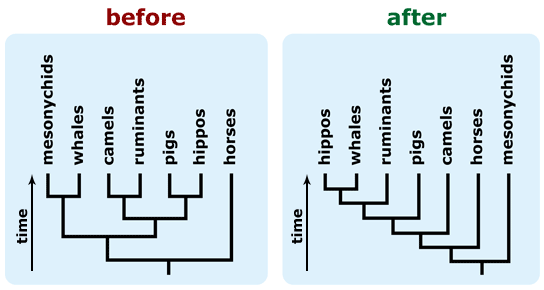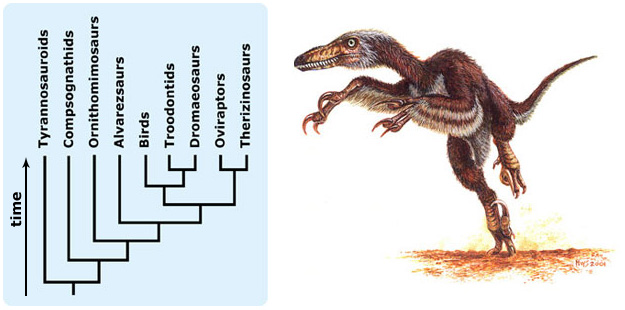If you had read about the evolutionary history of whales in the 1970s or 80s, you might have seen a tree that looks something like that shown below left, which implies that whales are closely related to an extinct group of mammals called the mesonychids. Today, we know that the origin of whales is better represented by the tree on the right. Whales and water-loving hippos are closely related! Why the change? Because the discovery of new DNA evidence caused paleontologists to re-evaluate their interpretations of the fossil evidence, leading to a revision of our understanding of the evolutionary relationships in this group.

Furthermore, we know that this branch of the mammal’s evolutionary tree will continue to grow as paleontologists dig further into the fossil record. Most organisms that have ever lived on Earth (including most ancient relatives of whales) have gone extinct. As new fossil organisms are discovered, biologists will have to figure out where on this tree they fit. In fact, we will never know the true evolutionary history of all whale-relatives because of the incompleteness of the fossil record. Many organisms that belong on this tree have gone extinct without leaving a trace in the fossil record. However, it’s important to keep in mind that, although this tree is incomplete and some details may change as we discover new evidence, it is still a good representation of the relationships among these groups of organisms and is based on many different converging lines of evidence.
This example highlights a basic characteristic of evolutionary trees: they are hypotheses that have been tested with evidence. Because they are supported by so many lines of evidence, widely accepted phylogenetic trees are unlikely to have their branches rearranged (though new branches are likely to be added as species are discovered). However, a change in our understanding is always possible. If new evidence is discovered or old evidence is reinterpreted, we must adjust our views of evolutionary relationships to reflect those data. Ignoring evidence would be bad science!
This doesn’t mean that trees change all the time. On the contrary, many evolutionary trees are so well supported (and continue to be supported by newly discovered evidence) that they are very likely to represent the evolutionary relationships among the organisms included accurately.4 For example, the idea that birds are a twig on the dinosaurs’ branch of the tree of life became widely accepted in the 1980s and 90s based on fossil and anatomical evidence. Subsequent decades have yielded evidence that further supports this hypothesis. Hundreds of feathered dinosaur fossils have been unearthed, and proteins extracted from a Tyrannosaurus rex fossil were found to be remarkably similar to those of a chicken. We’d all better get used to the idea that birds are part of the dinosaur lineage, because all the available evidence suggests that it is true and that the idea is here to stay! New feathered dinosaur species will certainly be discovered and we will need to add them to the tree, but such changes are very unlikely to shake our basic understanding of the close relationship between birds and dinosaurs.

You are likely to see these terms used interchangeably, though they have subtly different meanings. Technically, the term ‘phylogeny’ refers to the evolutionary history of a group of organisms. The terms ‘phylogenetic tree’ and ‘evolutionary tree’ are equivalent and refer to the tree-like structures that represent our hypotheses about that evolutionary history. The term ‘cladogram’ is used in a few different ways. Sometimes, it refers to a tree-like structure that represents the distribution of characters among a group of entities (which may or may not be organisms); sometimes, it refers to a tree on which the lengths of the branches are not relevant; and sometimes, it is used to mean the exact same thing as ‘phylogenetic tree.’ These vocabulary differences are subtle and are not consistently used in popular publications or even within the biological community. The important things for you to remember are that organisms are related and that we can represent those relationships with tree structures.
4 Of course, any phylogenetic tree is likely to be incomplete because of the existence of now-extinct lineages that belong on the tree but that we simply don't know about.
Trees adapted from: Geisler, J.H., and J.M. Theodor. 2009. Hippopotamus and whale phylogeny. Nature 458:E1-E4; Naylor, G.J.P, and D.C. Adams. 2001. Are the fossil data really at odds with the molecular data? Morphological evidence for Cetartiodactyla phylogeny reexamined. Systematic Biology 50:444-453; Zhou, X., S. Xu, Y. Yang, K. Zhou, and G. Yang. 2011. Phylogenomic analyses and improved resolution of Cetartiodactyla. Molecular Phylogenetics and Evolution 61:255-264; Zelenitsky, D.K., F. Therrien, G.M. Erickson, C.L. DeBuhr, Y. Kobayashi, D.A. Eberth, and F. Hadfield. 2012. Feathered non-avian dinosaurs from North America provide insight into wing origins. Science 338:510-514.
